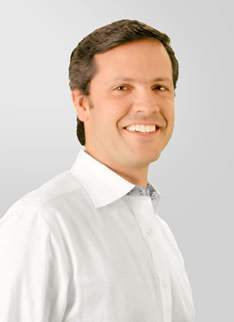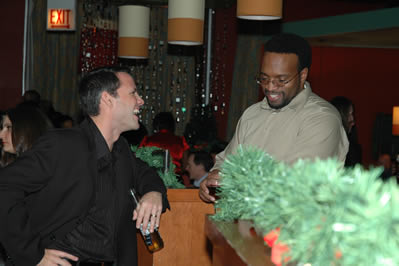
Matt Wise is the CEO of Q Interactive, and a really nice guy. But you’re here for interviews, and so Q Interactive’s interview is a good one – they actually started out as a coupons company (Cool Savings) and in the last few years completely reworked their direction to be a lead generation company. I think it’s yet another clear indicator that lead generation is one of the most powerful business models on the internet – many companies have reworked their business model in this same direction. We talk about the different methods of driving leads, what signifies “permission” and some sophisticated techniques to improve lead quality.
Full Interview Audio and Transcript
Personal Info
Hobbies and Interests: Spending Time with Kids, Reading.
Favourite Sports Teams: Chicago Bears, Chicago Cubs, Boston Red Sox.
Favourite Books:
- Atlas Shrugged by Ayn Rand
- Democracy in America by Alexis de Tocqueville
Company Website: http://www.qinteractive.com
Fast Track Interview
Adrian Bye: I’m here with Matt Wise, who is the CEO of Q Interactive. Matt, thanks for being here. Can you tell us a little bit about who you are and about Q Interactive?
Matt Wise: My pleasure, Adrian. We own and operate Cool Savings. As a matter of fact, the company used to be called Cool Savings. Its origin was in coupons. Over time, we were being paid six cents a print per coupon. Players like Uncle Ben’s came to us and said, “We really want to talk to our consumers. Instead of printing a coupon for them, if you could get them to sign up for a newsletter and to give permission to talk to them, we’d pay you $2 a person.”
Thus the concept of a lead gen network was born. We have been doing lead generation on the site since 1999. By 2004, we had inverted the model and made it available to other publishers. When we were a public company, we were doing about $30 million in revenue on Cool Savings. In the fourth quarter of 2004, we did about $5 million in our newly-formed lead generation ad network. In 2005, we did about $37 million on the network and about $30 million on our historical Cool Savings.
In the span of 18 months, we had shifted the entire business model from a Cool Savings-centric business to an ad network-centric business. The lead generation business and the publisher business continue to grow, and we have expanded into e-mail.
We found that the best way to match consumers and advertising is to use very rich data for the targeting. Since we sit behind the registration, we know a tremendous amount about the consumer, such as name, address, and age. From that, we can buy extra databases to figure out creditworthiness and a variety of other things. We use all of that to create advanced targeting algorithms to figure out the right offer for the consumer at any given time.
Adrian Bye: Are you a co-registration network generating leads?
 Matt Wise: We call ourselves a lead generation network as opposed to a co-registration network because people can’t sign up for more than one offer at a time. In the old model of co-registration, you signed up for one thing and were automatically signed up for two or three more. We never allow a consumer to sign up for offers simultaneously. They always have to go through an additional step, read more about a particular offer, and confirm if they’re really interested in that offer.
Matt Wise: We call ourselves a lead generation network as opposed to a co-registration network because people can’t sign up for more than one offer at a time. In the old model of co-registration, you signed up for one thing and were automatically signed up for two or three more. We never allow a consumer to sign up for offers simultaneously. They always have to go through an additional step, read more about a particular offer, and confirm if they’re really interested in that offer.
Adrian Bye: Do you allow pre-checked leads so you always force the consumers to go through at least one more step?
Matt Wise: We do allow pre-checked leads. Whenever you have a pre-checked lead, they ask to go through one more step, so we view the pre-check as a recommendation.
It’s impossible to get through and say, “I didn’t know I signed up for the Gap,” because not only did you get the little pre-checked or unchecked box that you had to check, but then you had this fuller page with which you had to interact. You had to confirm all your information. You had to answer another question and hit “Submit” again. There’s also a skip button, so they can say, “Oh, now that I understand what I’m signing up for, I don’t want to do this.” For complicated ones where we have a telephone call following it, we do a triple opt-in. In that case, after you press “Submit,” we’ll put a little warning box up that says, “Hey did you really read this closely? Someone is going to give you a call.” They then have to press “Submit” again.
What we do find is some less scrupulous players in the field take your data and they resell it to five or six other players. You’ve only signed up for one site, but now you’re getting mail from six other players. The reason is because your data is being resold.
Adrian Bye: What’s your policy on that kind of stuff?
Matt Wise: Our policy is that permission should be clear and conspicuous on the page in either an active opt-in where is there’s a checkbox and it’s not checked, or a passive opt-in where we pre-checked the opt-in box, and it clearly says, “Hey, you’re opting in for mail.” If you do all that, you put all the power in the consumer’s hands and it still allows for direct marketers and promotional marketers to run a robust business.
Adrian Bye: You saw that co-registration or lead generation works really well, and you started to make this the focus of your business. Is that correct?
 Matt Wise: Not only did we find that lead generation was a good idea, but when we had so many advertisers coming to us who wanted lead generation, we ended up with the very simple problem of which advertiser we should feature. Thus was born the beginning of our yield management system. Right now, lead generation is a relatively simple concept on the surface. Wal-Mart wants leads. You put the Wal-Mart offer up. Someone fills it out. You send the data feed to Wal-Mart.
Matt Wise: Not only did we find that lead generation was a good idea, but when we had so many advertisers coming to us who wanted lead generation, we ended up with the very simple problem of which advertiser we should feature. Thus was born the beginning of our yield management system. Right now, lead generation is a relatively simple concept on the surface. Wal-Mart wants leads. You put the Wal-Mart offer up. Someone fills it out. You send the data feed to Wal-Mart.
Where it gets complicated is predicting what consumers actually want Wal-Mart and when the Wal-Mart offer is going to yield higher than the Disney offer, the Target offer, or the mortgage offer. That’s where you get the higher-end players and build very complex algorithms and mathematical equations to make predictions. Then there’s a whole other business on the back end of how do I confirm that the person was bona fide. We try to do that in the user experience and in the background by cleaning up addresses, checking on addresses, or preparing the data to be sent to the client.
Adrian Bye: What kind of eCPM can people see for their site by adding your registration?
Matt Wise: It depends on the implementation. We have people at the low end who may be presenting only six offers, no pre-checks, and they’ll exclude some of the more hard-core direct marketing players who pay high premiums. On those, you may be talking about $75 eCPM.
At the high end, our best performers, who have the most aggressive paths that take a lot of work, probably peak out at $1,800 eCPM. Our average is around $500 eCPM.
Adrian Bye: What is in the user’s mind when they complete the offer?
Matt Wise: The key is that the consumer never feels they have to fill in the offer. Unscrupulous players insinuate to the user that they have to fill something out in order to get to the next page. We control and demand that all our publishers never use any language that may insinuate that an offer has to be taken; otherwise, you start to degrade the quality leads you send them. The reason these folks can generate such a high eCPM is they attract consumers who really like to sign up for stuff.
Adrian Bye: What is the ideal traffic you want most?
Matt Wise: The reality is we like all traffic. We have about 1,500 advertisers a year running through the system, so we have offers that appeal to all the different segment groups. Those who monetize the absolute best are women probably aged 25 to 50. They shop and buy more online and are more willing to sign up for things online.
Adrian Bye: Who generates the scorecards you use?
Matt Wise: We do it all ourselves. We have a staff of about half a dozen statisticians and mathematicians. All they do is build the models and advance the targeting. We also work with some offline data companies such as a company called Alliant, who aggregates pay-up rates from people like National Geographic, BMG Music Club and others. They create custom models and score people as to the propensity of people paying their bills. We can apply that to the algorithm, but the rest of the algorithms are built.
Adrian Bye: Was that something you introduced one day to the next?
Matt Wise: It’s a constant iterative process. At first, it was just putting different offers in front of males and females. Then step-by-step it became more complicated. Now it’s so complicated that sometimes you wonder where or why offers are showing. The targeting engine is smarter than the rest of us in figuring out what people will likely want. Each time we make an advance or add another data point, it raises yields anywhere from usually one percent to five percent, depending on how advanced the targeting element is.
Adrian Bye: Are you looking up things on each user to make determinations? Do you access any Equifax databases or things in real time to make sure things work or is it just based on the data that you have?
 Matt Wise: It’s twofold. We do buy data from Alliant and some other players, not all of which we disclose. Most of it is done behind the scenes prior to the consumer’s arrival. We take consumers and match the likelihood of activity before they arrive. We do some things on the fly, such as behavioral targeting. If a person took a fitness offer, we’re going to show them a health food offer next because we know the propensity for them to take one after the other is very high. We’ll do a lot of the pay-up rates and more advanced mathematics behind the scenes. When they arrive, we can immediately peg them to a particular user group. We can predict a whole plethora of things such as ethnicity, household income, and likelihood to own a home versus rent.
Matt Wise: It’s twofold. We do buy data from Alliant and some other players, not all of which we disclose. Most of it is done behind the scenes prior to the consumer’s arrival. We take consumers and match the likelihood of activity before they arrive. We do some things on the fly, such as behavioral targeting. If a person took a fitness offer, we’re going to show them a health food offer next because we know the propensity for them to take one after the other is very high. We’ll do a lot of the pay-up rates and more advanced mathematics behind the scenes. When they arrive, we can immediately peg them to a particular user group. We can predict a whole plethora of things such as ethnicity, household income, and likelihood to own a home versus rent.
Adrian Bye: Are there other aspects of your business we haven’t talked about that we should?
Matt Wise: Lead generation is the primary aspect, but we can also monetize a publisher’s e-mail. We use the same algorithms and the same logic of looking at all of the consumers to determine the best offer to match that consumer on a given day.
Adrian Bye: How do you figure out a user is likely to do something when all you have is their e-mail address or do you have more data?
Matt Wise: Usually we have more data because when they go through these sites, we ask for the registration data. For some subsets, the only thing we have is e-mail, so we have to wait until a person takes an action before we can put them somewhere.
For example, as soon as they take an offer, I start to see some behavioral history behind that consumer and see that they are starting to skew toward a specific behavioral. We’re just starting to target banners based on this data we have.
Adrian Bye: What are you doing for advertisers? Are you taking people to landing pages or are you putting them through more registration processes?
Matt Wise: Off the banners, they could go to either a registration page, a landing page for a particular offer or to someone’s site.
For example, Colorado Tourism wants to drive people back to their site. They may have come to us and said, “We only want people from the surrounding four states.” Most of the time, a contextual site would say they couldn’t do that. Since we have the registration data, we would say, “No problem.”
An even better example is that we take offers where people have franchises in 150 locations around the country. They want different ads in front of every one of them. That’s a nonstarter for most ad networks. Since we have the registration data, we say, “No problem. This offer will go to the folks in Florida. This offer will go to the folks in Southern Texas.” The CPMs they pay, theoretically, will be substantially higher. This concept of the banner network is still in its early stage. We’re just starting to test it now. From what we can see, it’s going to be great.
Adrian Bye: Do you have problems with fraud?
Matt Wise: Not that much and the primary reason is the way we run our publisher network. We don’t have a self-serve tool. All of the publishers we work with have been specifically hand-chosen. The likelihood that one of them would commit fraud is low because obviously they’re going to get cut off from us. We don’t have the same challenges as many of the affiliate networks have where a publisher comes in and doesn’t worry about getting cut off by an affiliate network because they’re only doing 100 registrations a day. If they get cut off by one affiliate network, they’ll hop to the next. Also, we don’t do a lot on the credit card side. Most of our stuff is soft offers, meaning you sign up for a newsletter or whatever else. There’s not a lot of benefit for random people to go sign up for $0.50 offers. They have to fill out literally thousands of them before they make any real money.
However, fraud’s still an issue on two levels. You worry about individual publishers trying to goose their numbers by just entering information, and you worry about un-bona fide users. We try to figure out and define whether people are putting in un-bona fide information.
We build screens on the background to ask if it is really a person. Does this person match the address? Is this Fred Flintstone or is it some other commonly-used and constructed fake name? Often times, we don’t even correct that on the front form. If we see someone who says they’re John Smith from 123 Main Street, we let them submit that. We just take it in and we can get it in the background. We predict the ones that are more likely to be fraudulent than real, so we just take them out of the system. If we’ve rejected them on the front page, then all the consumer does is keep get creative until they find something we haven’t discovered yet.
Adrian Bye: Is there anything else you want to add in closing?
Matt Wise: We see tremendous growth both in the interactive space and our lead generation space. The key is doing it responsibly and finding that right balance of feeding in advertising but not disenfranchising the consumer and concerns about user revolutions. Consumers have a greater appreciation than most people think for advertising as long as it’s their option and they can delete it when they want.
Adrian Bye: Thank you very much for your time.
Matt Wise: Adrian, it’s very good talking to you. Thank you.









